
In Greek mythology, Achilles or Achilleus was a hero of the Trojan War, the greatest of all the Greek warriors, and the central character of Homer's Iliad. He was the son of the Nereid Thetis and Peleus, king of Phthia.

In Greek mythology, the Nereids or Nereides are sea nymphs, the 50 daughters of the 'Old Man of the Sea' Nereus and the Oceanid Doris, sisters to their brother Nerites. They often accompany Poseidon, the god of the sea, and can be friendly and helpful to sailors.

In Greek mythology, Chiron was held to be the superlative centaur amongst his brethren since he was called the "wisest and justest of all the centaurs".

Publius Papinius Statius was a Greco-Roman poet of the 1st century CE. His surviving Latin poetry includes an epic in twelve books, the Thebaid; a collection of occasional poetry, the Silvae; and an unfinished epic, the Achilleid. He is also known for his appearance as a guide in the Purgatory section of Dante's epic poem, the Divine Comedy.
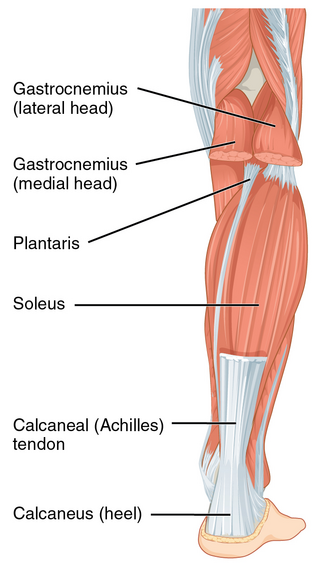
The Achilles tendon or heel cord, also known as the calcaneal tendon, is a tendon at the back of the lower leg, and is the thickest in the human body. It serves to attach the plantaris, gastrocnemius (calf) and soleus muscles to the calcaneus (heel) bone. These muscles, acting via the tendon, cause plantar flexion of the foot at the ankle joint, and flexion at the knee.
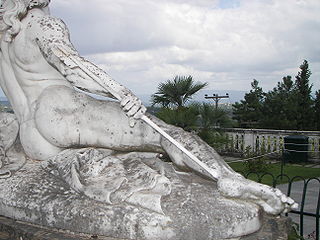
An Achilles' heel is a weakness in spite of overall strength, which can lead to downfall. While the mythological origin refers to a physical vulnerability, idiomatic references to other attributes or qualities that can lead to downfall are common.

Marco Girolamo Vida or Marcus Hieronymus Vida was an Italian humanist, bishop and poet.

Lucius Junius Moderatus Columella was a prominent writer on agriculture in the Roman Empire.

Giuseppe Simone Assemani (Classical Syriac : ܝܵܘܣܸܦ ܒܲܪ ܫܸܡܥܘܿܢ, was a librarian, Lebanese Maronite orientalist, and Catholic bishop. For his efforts, and his encyclopedic knowledge, he earned the nickname "The Great Assemani".

The Achilleid is an unfinished epic poem by Publius Papinius Statius that was intended to present the life of Achilles from his youth to his death at Troy. Only about one and a half books were completed before the poet's death. What remains is an account of the hero's early life with the centaur Chiron, and an episode in which his mother, Thetis, disguised him as a girl on the island of Scyros before he joined the Greek expedition against Troy.

The Roman Catechism or Catechism of the Council of Trent is a compendium of Catholic doctrine commissioned during the Counter-Reformation by the Council of Trent, to expound doctrine and to improve the theological understanding of the clergy. It was published in 1566.
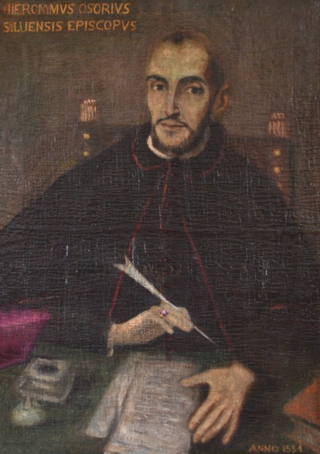
Jerónimo Osório da Fonseca was a Portuguese Roman Catholic humanist bishop, historian and polemicist. An extensive notice of his life and thought (Vita) was written by his nephew, a canon of Évora also named Jerónimo Osório, to introduce his edition of his uncle's Complete Works published in 1592.
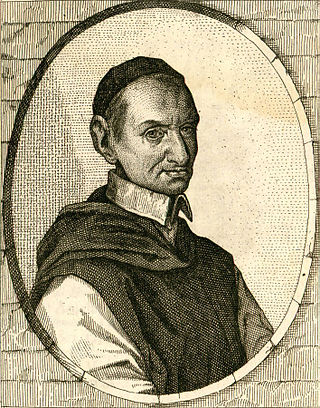
Paolo Silvio Boccone was an Italian botanist from Sicily, whose interest in plants had been sparked at a young age. Born in a rich family, he was able to dedicate most of his life to the study of botany.

The Collège Sainte-Barbe is a former college in the 5th arrondissement of Paris, France.

Giovanni BaptistaFerrari, was an Italian Jesuit and professor in Rome, a botanist, and an author of illustrated botanical books and a Syriac-Latin dictionary. Linguistically highly gifted and an able scientist, at 21 years of age Ferrari knew a good deal of Hebrew and spoke and wrote excellent Greek and Latin. He became a professor of Hebrew and Rhetoric at the Jesuit College in Rome and in 1622 was editor of a Syriac-Latin dictionary.

Paulinus of St. Bartholomew was an Austrian Carmelite missionary and Orientalist of Croatian origin. He is known by several names as Paulinus S. Bartholomaeo, Paolino da San Bartolomeo, Paulinus Paathiri, Paulin de St Barthelemi, Paulinus A S. Bartholomaeo, Johann Philipp Wesdin, or Johann Philipp Werdin.

The Biblioteca Vallicelliana is a library in Rome, Italy. The library is located in the Oratorio dei Filippini complex built by Francesco Borromini in Piazza della Chiesa Nuova.
Antonius Agellius, C.R. or Antonio Agellio (1532–1608) was bishop of Acerno and a member of the Theatines, born in Sorrento. He was an editor of the Clementine edition of the Latin Vulgate.
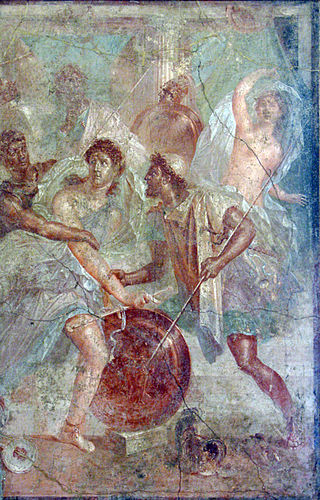
Achilles on Skyros is an episode in the myth of Achilles, a Greek hero of the Trojan War. Not existing in Homer's epic poem Iliad, the episode is written down in detail in some later versions of the story, particularly the Achilleid by the Roman poet Statius. The story of how Achilles disguised himself as a girl at the court of the king of Skyros, fell in love with one of the princesses, and married her before leaving for Troy, became a popular topic in arts and literature from Classical times until the middle of the 20th century. The carnivalesque disguises and gender transpositions at the heart of the story were particularly popular in opera, with over 30 different operas on the theme between 1641 and 1857.
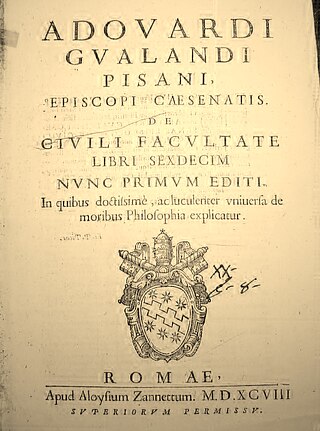
Odoardo Gualandi descended from an old and famous patrician family from Pisa. At the University of Bologna he graduated summa cum laude in civil and canon law.

















